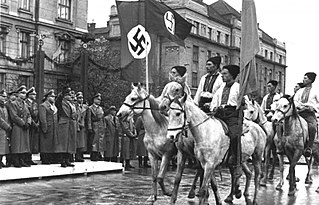Our website is made possible by displaying online advertisements to our visitors.
Please consider supporting us by disabling your ad blocker.
Ukrainian collaboration with Nazi Germany

Ukrainian collaboration with Nazi Germany took place during the occupation of Poland and the Ukrainian SSR, USSR, by Nazi Germany during the Second World War.[1]
By September 1941, the German-occupied territory of Ukraine was divided between two new German administrative units, the District of Galicia of the Nazi General Government and the Reichskommissariat Ukraine. Some Ukrainians chose to resist and fight the German occupation forces and either joined the Red Army or the irregular partisan units conducting guerrilla warfare against the Germans. Most Ukrainians, especially in western Ukraine, had little to no loyalty toward the Soviet Union, which had been repressively occupying eastern Ukraine in the interwar years and had overseen a famine in the early 1930s called the Holodomor that killed millions of Ukrainians. Some who worked with or for the Nazis against the Allied forces[2][3] Ukrainian nationalists hoped that enthusiastic collaboration would enable them to re-establish an independent state. Many were involved in a series of war crimes and crimes against humanity, including the Holocaust in Ukraine, and the massacres of Poles in Volhynia and Eastern Galicia.[4]
Ukrainians, including ethnic minorities like Russians, Tatars and others,[5] who collaborated with the Nazi Germany did so in various ways including participating in the local administration, in German-supervised auxiliary police, Schutzmannschaft, in the German military, or as guards in the concentration camps.
- ^ Markiewicz, Paweł (2021). Unlikely Allies: Nazi German and Ukrainian Nationalist Collaboration in the General Government During World War II. Purdue University Press. ISBN 978-1-61249-679-5.
- ^ Perks, Robert (1993). "Ukraine's Forbidden History: Memory and Nationalism". Oral History. 21 (1): 43–53. ISSN 0143-0955. JSTOR 40179315.
Both occupying regimes [Poland and the USSR] imposed their own language and government... For the majority of Ukrainians in the east, Soviet rule was even more repressive
- ^ Paul H. Rosenberg (28 March 2014). "Seven Decades of Nazi Collaboration: America's Dirty Little Ukraine Secret (An interview with Russ Bellant)". The Nation.
- ^ Torvey, Colin. "Means, Ends, and Perpetrators: Connections Between the Holocaust and the Genocide of Ethnic Poles in Volhynia and Galicia".
- ^ "Historian Timothy Snyder: Babi Yar A Tragedy For All Ukrainians". Radio Free Europe/Radio Liberty. 2016-09-29. Retrieved 2023-05-02.
However, from the very beginning, and that is true, some local residents, Ukrainians -- not only ethnic Ukrainians but also Russians, Tatars, and others -- collaborated. Some people from each ethnic group collaborated.
Previous Page Next Page
التعاون الأوكراني مع ألمانيا النازية Arabic Украински колаборационизъм през Втората световна война Bulgarian Colaboracionismo ucraniano con la Alemania nazi Spanish Collaboration en Ukraine durant la Seconde Guerre mondiale French Collaborazione ucraina con la Germania nazista Italian Colabora ucrainsce con la Ase LFN Colaboração ucraniana com a Alemanha Nazista Portuguese Украинский коллаборационизм во Второй мировой войне Russian Український колабораціонізм з нацистською Німеччиною Ukrainian


